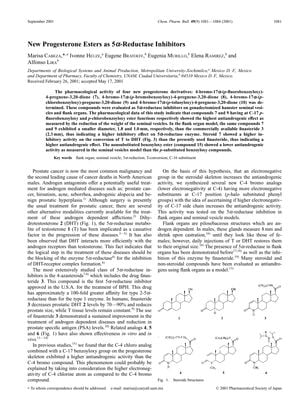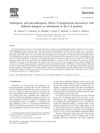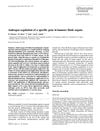New Progesterone Esters as 5α-Reductase Inhibitors
January 2001
in “
Chemical & Pharmaceutical Bulletin
”
progesterone esters 5α-reductase inhibitors androgenic alopecia 4-bromo-17α-(p-fluorobenzoyloxy)-4-pregnene-3,20-dione 4-bromo-17α-(p-bromobenzoyloxy)-4-pregnene-3,20-dione 4-bromo-17α-(p-chlorobenzoyloxy)-pregnene-3,20-dione 4-bromo-17α-(p-toluoyloxy)-4-pregnene-3,20-dione testosterone dihydrotestosterone DHT finasteride 5-alpha-reductase inhibitors androgenic alopecia testosterone DHT Propecia

TLDR Some new progesterone derivatives are better at blocking testosterone conversion than a common drug.
In 2001, researchers tested four new progesterone derivatives as 5α-reductase inhibitors, which are relevant for treating androgen-dependent conditions such as prostate cancer and androgenic alopecia. The compounds tested were 4-bromo-17α-(p-fluorobenzoyloxy)-4-pregnene-3,20-dione (7), 4-bromo-17α-(p-bromobenzoyloxy)-4-pregnene-3,20-dione (8), 4-bromo-17α-(p-chlorobenzoyloxy)-pregnene-3,20-dione (9), and 4-bromo-17α-(p-toluoyloxy)-4-pregnene-3,20-dione (10). These compounds were evaluated using gonadectomized hamster seminal vesicles and flank organs. The study found that compounds 7 and 9 had the highest antiandrogenic effect, with compound 7 showing more inhibitory activity on the conversion of testosterone to dihydrotestosterone (DHT) than finasteride, a commercially available drug. The study concluded that an electronegative group at the C-17 position of the steroid structure increased antiandrogenic activity, with the fluorine atom in compound 7 contributing to its effectiveness. The exact number of animals used in the study was not mentioned.





